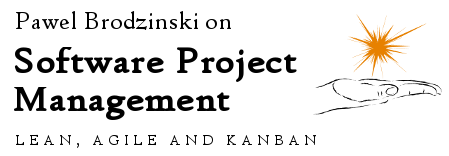This is another problem that comes in different colors. It’s either simple acceptation of WIP limits violation, no matter how commonly it happens, or setting WIP limits so high that a team never gets even close.
Now, I don’t say that violating WIP limits should be forbidden at all. Pretty far from that. I just say that if it is a common thing it basically means that you have no limits at all. The same is with too loose WIP limits – it means no limits at all. It’s always a matter of balance: when and why you accept to violate WIP limits.
I point this issue high on my list as basically not using WIP limits means that you voluntarily resign from the biggest gain you can get out of introducing Kanban – the rate of improvements and changes you introduce in the team is way slower. It is so because WIP limits are a mechanism that incentivize people to change their behavior (they would normally do one thing but they can’t as it would mean violating WIP limit so they do another). Without changing behaviors most changes are quickly rolled back to what people know and feel comfortable with.
When you start thinking about the issue it may be a very complex one and as such may be approached from different directions. One thing which is pretty obvious: make abusing WIP limits painful. I don’t mean here physically painful of course, but add enough hassle that people would think twice before doing it.
A neat trick I used was that every time someone wanted to violate WIP limit they had to organize a meeting with a team and tell everyone why they’re doing so. First, organizing a meeting, even an ad-hoc one, takes some time which you may use to rethink whether this is really needed. Second, you want to have pretty damn good reason to share as everyone will like to know why you’re breaking the rule. Actually, if you could come up with good argument you probably had a point in violating a limit anyway. You can use other similar methods as well, but basically the goal would be the same – to make abusing limits reasonably uncomfortable.
Different approach will be needed to deal with unreasonably high WIP limits. A thing that may come handy in such case is measuring WIP over a period of time. It is an interesting observation but some teams believe that they actually have more WIP than they really do. In such case once you’ve measured your work in progress you shouldn’t be scared of limits. Even more, your initial decisions on WIP limits will be informed.
Another idea is to reduce WIP limits periodically to see what will happen. Eventually the team would find their sweet spots, where limits are tight enough so that they’re incentivized to improve but loose enough that the inconvenience of having WIP limits is acceptable. It is like playing ball flow game, but on the real work done in a real team.
Check the other pitfalls of Kanban as well.
Advertisement: Infragistics® NetAdvantage® for Windows Forms provides developers with flexible, advanced controls to rapidly build high-fidelity Windows Forms application user interfaces “IN” style with the look and feel of Microsoft® Office® 2010 and Windows® 7. It Features every control developers need to deliver superior user experiences with stability, performance and robustness.


 Subscribe RSS feed
Subscribe RSS feed Follow on Twitter
Follow on Twitter Subscribe by email
Subscribe by email



0 comments… add one